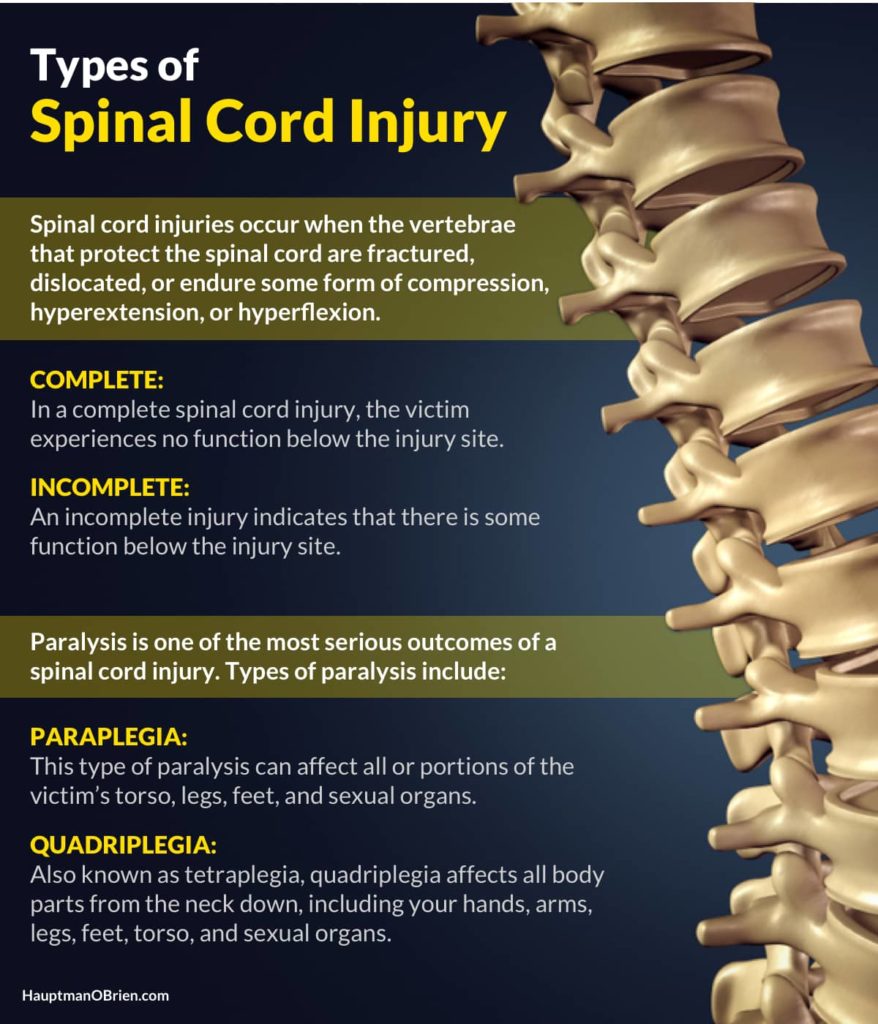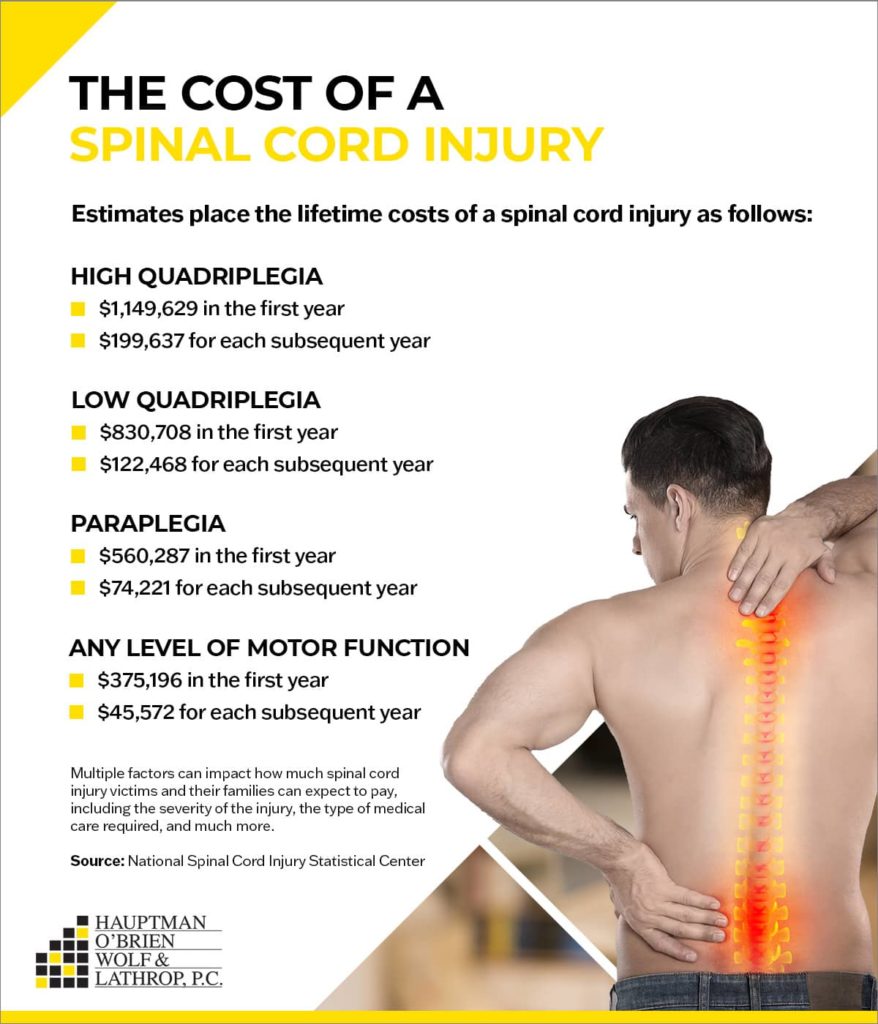Dedicated Omaha Spinal Cord Injury Attorneys Serving Nebraska
Spinal cord injuries are devastating. In addition to loss of mobility and sensation, victims of injury to the spine often suffer a wide range of complications. These may include muscle spasms, chronic pain, loss of bladder and bowel control, problems with the heart and cardiovascular system, breathing difficulties, sexual dysfunction, loss of bone density, trouble regulating body temperature, and more.
The economic ramifications of a spinal cord injury are immense. Victims and their families may spend more than $1 million for initial treatment of the injury, followed by tens of thousands to hundreds of thousands of dollars each year for ongoing care.
It may be difficult or even impossible for spinal cord injury victims to return to work, exacerbating the financial hardship. Quality and enjoyment of life also decline as a result of the physical, mental, emotional, and financial issues.
You should not have to bear the burdens alone if you suffered a spinal cord injury as a result of someone else’s negligence. The attorneys at Hauptman, O’Brien, Wolf & Lathrop draw on more than 298 years of combined personal injury experience to pursue the full compensation you deserve.
Please contact Hauptman, O’Brien, Wolf & Lathrop by calling (402) 241-5020 today for a FREE case review. Our spinal cord injury attorneys serve clients in Omaha, Sarpy County, and throughout Nebraska and nearby Iowa.

What Is a Spinal Cord Injury?
The spine is made up of 33 vertebrae divided into five distinct sections (cervical, thoracic, lumbar, sacral, and coccyx). Running through these vertebrae is the spinal cord, a dense column of nerve tissue responsible for transmitting and receiving signals throughout the body.
Unfortunately, the spinal cord is extremely vulnerable to injury. Spinal cord injuries are divided into one of two different categories:
- Complete Spinal Cord Injury: In a complete spinal cord injury, the victim experiences no function below the injury site. This loss of sensation and movement affects both sides of the body equally and can occur anywhere along the spinal cord.
- Incomplete Spinal Cord Injury: An incomplete injury indicates that there is some function below the injury site. Incomplete spinal cord injuries are characterized by varying levels of sensation and movement throughout the body, though one side is usually more affected than the other. An incomplete spinal cord injury can also occur anywhere along the spinal cord.
The severity of a spinal cord injury is graded according to the ASIA Impairment Scale. Formulated by the American Spinal Injury Association (ASIA), the Impairment Scale assesses muscle function after trauma to the spinal cord has taken place. The grades of spinal cord injury are:
- Grade A: Complete spinal cord injury, total paralysis
- Grade B: Incomplete spinal cord injury, some sensation but no muscle function
- Grade C: Incomplete spinal cord injury, some sensation with less than 50% muscle function below injury site
- Grade D: Incomplete spinal cord injury, some sensation and more than 50% muscle function below injury site
- Grade E: Normal/non-paralyzed
Finally, although not all spinal cord injuries result in paralysis, it is important to be aware of this worst-case scenario. Most people are aware of the following two types of paralysis after a spinal cord injury:
- Paraplegia: This type of paralysis can affect all or portions of the victim’s torso, legs, feet, and sexual organs.
- Quadriplegia: Also known as tetraplegia, quadriplegia affects all body parts from the neck down, including your hands, arms, legs, feet, torso, and sexual organs.
A spinal cord injury can also result in hemiplegia, or paralysis of one half of the body. Victims of hemiplegia may lose sensation and muscle function in the arm, leg, and torso on the left or right side while the other side remains functional.
What Causes a Spinal Cord Injury?
The latest fact sheet from the National Spinal Cord Injury Statistical Center estimates that the annual incidence of spinal cord injuries is 17,730 people per year. That’s 54 new cases each year for every 1 million people in the United States.
Many different incidents can lead to a spinal cord injury. Some of the most common causes our spinal cord injury lawyers see include:
- Car Accidents
- Truck Accidents
- Motorcycle Accidents
- Pedestrian Accidents
- Bicycle Accidents
- Slip and Fall Accidents
- Job-Related Accidents
- Medical Malpractice (ex: failure to diagnose a stroke, errors during spinal surgery, etc.)
- Defective Products (ex: malfunctioning machinery, faulty auto components, etc.)
- Boating Accidents
Physical violence is another leading cause of spinal cord injuries. Blunt trauma and sharp force injuries to the neck and back can both damage the spinal cord.

Who Is At Fault for a Spinal Cord Injury?
Determining the cause of a spinal cord injury is usually quite straightforward. However, to recover compensation for the injury and your subsequent damages, you need to ascertain who is at fault.
A spinal cord injury lawyer will need to prove the following to establish the fault of the defendant(s) in your spinal cord injury claim:
- First, the defendant owed you a duty of care (i.e., an obligation to take reasonable precautions for your safety)
- Second, the defendant breached this duty through negligence
- Third, you suffered a spinal cord injury as a result of the defendant’s negligence
- Finally, you incurred damages as a result of the spinal cord injury
Fault for an accident that gives rise to a spinal cord injury may rest with one or more parties. Although the exact circumstances may vary, some of the common scenarios involving fault for a spinal cord injury include:
Spinal Cord Injuries in Motor Vehicle Accident Claims
The most straightforward example of fault for a spinal cord injury is an auto accident where a driver hits you from behind (a major cause of injuries to the neck and back, potentially resulting in spinal cord damage). Speeding, distracted driving, and other negligent behaviors commonly lead to a driver crashing into the back of another vehicle.
As a result, the driver in the back is generally found to be at fault for a rear-end accident. If the evidence in your case supports this conclusion, you can bring a claim against the driver who rear-ended you and caused the spinal cord injury.
Spinal Cord Injuries in Premises Liability Claims
If you suffer a spinal injury in a fall on a property owned and operated by someone else, it is important to survey the nearby area for dangerous conditions. You may be entitled to compensation if the property owner or occupant was negligent in its duty to keep the premises free of slipping and tripping hazards.
Similar arguments may apply if you are the victim of a violent offense on another’s property. Property owners can be held liable for injuries sustained by lawful visitors as a result of negligent security.
Spinal Cord Injuries in Product Liability Claims
Consumers can suffer a range of serious injuries in encounters with defective products. Injury to the spinal cord may occur as a result of the following:
- Design defects
- Manufacturing defects
- Failure to warn (i.e., negligent labeling/marketing)
One or more of these factors can make a product unsafe for its intended purpose. If you suffer a spinal cord injury (or any other kind of harm) due to these defects, multiple individuals and businesses involved in the creation, distribution, and sale of the product may be liable.
Read More: Who Is Liable for Product Defects?
Spinal Cord Injuries in Medical Malpractice Claims
Doctors and other medical professionals can be held liable for negligence arising from errors (wrongful acts) and omissions (failure to act). A few different scenarios may apply when it comes to spinal cord injuries resulting from medical malpractice:
- An injury to the spine is misdiagnosed, resulting in complications
- The spine is damaged as a result of negligent medical care
- Misuse of medical equipment damages the spinal cord
Multiple medical providers may be liable for damages if malpractice results in a spinal cord injury. Hospitals and other facilities can also be held liable if an employee’s negligence harms a patient.
Spinal Cord Injuries in Work Injury Claims
If you are injured on the job, your employer’s workers’ compensation insurance will pay for medical expenses related to the injury and a portion of your lost wages if you are unable to work. Employees who suffer a spinal cord injury in a work-related accident may qualify for permanent partial disability or total disability benefits.
Read More: How to Get Workers’ Comp Disability Benefits
Generally, workers cannot sue their employers for injuries sustained on the job. However, a third party may be liable if negligence causes a work-related accident that damages your spine.

What Compensation Can I Recover for a Spinal Cord Injury?
Spinal cord injuries affect virtually all aspects of life. As a result, victims and their loved ones are often entitled to significant compensation if the spinal cord injury was caused by the negligence of another party.
An experienced spinal cord injury lawyer can assess all of the damages in your case to determine how much you may be able to recover. You may be entitled to compensation for the following losses:
- Medical expenses, including transportation via ambulance, emergency room care, surgery, hospitalization, etc.
- The cost of rehabilitation and therapy
- Lost wages
- Loss of earning capacity – the income and benefits you stand to lose if the spinal cord injury renders you unable to work in the future
- Out-of-pocket costs, including:
- Prescription medications
- Wheelchairs and other assistive devices
- Accessibility modifications to your home and vehicle
- Home-based services
- Travel for medical care and therapy
- Pain and suffering
- Emotional anguish
- Disability
- Loss of consortium
Without the assistance of a knowledgeable spinal cord injury attorney, it is easy to overlook some of the damages you may be due. You only have one chance to recover compensation, so it is crucial to hire a lawyer with experience handling spinal cord injury claims.
You may not need to file a lawsuit to recover fair compensation for a spinal cord injury. Many personal injury claims – even those involving catastrophic injuries – are resolved via settlement with the at-fault party’s insurance company.
However, the seriousness of the injury and the extent of damages also increases the likelihood that the insurer will dispute your claim. This could lead to prolonged negotiations and potentially result in the insurer refusing to offer you a fair settlement.
If this is the situation, you need an experienced trial attorney who can effectively present your case in court and achieve a favorable outcome on your behalf.
Do You Need a Spinal Cord Injury Lawyer?
Any personal injury claim involving catastrophic injuries requires specialized legal support. Spinal cord injuries are extremely complex, and claims involving these injuries should not be handled alone.
If you try to take on a spinal cord injury claim by yourself, you are likely to face a number of serious challenges. Your priority should be your recovery and rehabilitation, not arguing with insurance companies.
Our spinal cord injury lawyers can assist you with multiple aspects of your claim, including:
- Gathering evidence of what caused your spinal cord injury
- Identifying who is at fault for the injury
- Determining liability for damages/available insurance coverage
- Calculating the current and future damages you are due
- Hiring expert witnesses to review the evidence and provide testimony
- Negotiating a spinal cord injury settlement with the insurance company
- If necessary, filing a lawsuit on your behalf
- Taking your case to trial as needed
Spinal cord injury claims often involve substantial damages. You may require surgical intervention, rehabilitation to learn how to deal with partial or complete loss of functionality, and ongoing care. The full extent of necessary treatments and therapies (as well as the financial ramifications) will likely not be apparent until the swelling from the initial trauma to the spinal cord subsides and the injury begins to stabilize.
All of these factors make it difficult for spinal cord injury victims to realize the long-term effects on their life. If you try to handle the case on your own, you run the risk of settling for far less than you deserve.
Experienced spinal cord injury lawyers can handle these challenges on your behalf. At Hauptman, O’Brien, Wolf & Lathrop, our attorneys have the knowledge and resources to determine who is responsible for your spinal cord injury and assess the full value of your claim.
We answer your questions about your spinal cord injury case and update you regularly on our progress. Our firm handles every case with integrity, so you can count on us to provide honest advice and the highest quality of service.
Our goal is to obtain full and fair compensation on your behalf. Generally, this is achieved by negotiating a settlement with the insurance company. However, our spinal cord injury attorneys never hesitate to take a case to court if it means getting the result you deserve.
Contact an Omaha Spinal Cord Injury Lawyer Today
If you or a loved one suffered a spinal cord injury due to someone else’s negligence, it likely feels like your life has been turned upside down. Hauptman, O’Brien, Wolf & Lathrop can help.
Our spinal cord injury attorneys understand the unique challenges of these claims. We take a personalized approach to every case that enables us to provide the support you need and fight for the compensation you deserve.
Please call Hauptman, O’Brien, Wolf & Lathrop at (402) 241-5020 today for a FREE case review. Our spinal cord injury lawyers serve clients in Omaha, Sarpy County, and other areas of Nebraska and Iowa.
Spinal Cord Injury FAQ
What Section of the Spinal Cord Suffers the Most Injuries?
The portion of the spine in the neck (the cervical spine) is the most vulnerable to injury. One of the most common causes of injury to the cervical spine is the whipping motion that occurs in car accidents, when someone is struck in the face, and other traumatic events.
Damage to the cervical vertebrae can range in severity from ligament and tendon strains in the neck to herniation of one or more discs to broken vertebrae. In extreme cases, the spinal cord may be damaged as well.
First responders take special care to assess accident victims for cervical injuries and stabilize the neck for safe transportation to the emergency room. In cases of suspected spinal cord trauma, medical professionals will fully evaluate the neck injury to determine the nature and extent of the damage.
What Is the Most Serious Type of Spinal Cord Injury?
All spinal cord injuries are serious. However, the most severe is a complete cervical spinal cord injury. Depending on the location and the seriousness of the damage, victims of a complete injury to the cervical spinal cord may suffer total loss of function and sensation below the neck – a condition known as quadriplegia.
Quadriplegia is life-altering. Victims are often unable to walk and have little to no use of their arms. These issues significantly impact their ability to live independently, engage in certain careers, take part in leisure activities and hobbies, and other aspects of life.
Read More: What Are the Grades of a Spinal Cord Injury?
Most cases of quadriplegia result from damage to the C3, C4, C5, C6, or C7 vertebra. Injuries to the C1 or C2 vertebra can also lead to total paralysis, but the more common outcome of such an injury is death.
What Is the Lifetime Cost of a Spinal Cord Injury?
Multiple factors can impact how much spinal cord injury victims and their families can expect to pay, including the severity of the injury, the type of medical care required, and much more. The most recent data from the National Spinal Cord Injury Statistical Center estimates the lifetime costs of a spinal cord injury as follows:
- High quadriplegia (most severe):
- $1,149,629 in the first year
- $199,637 for each subsequent year
- Low quadriplegia:
- $830,708 in the first year
- $122,468 for each subsequent year
- Paraplegia:
- $560,287 in the first year
- $74,221 for each subsequent year
- Any level of motor function impairment:
- $375,196 in the first year
- $45,572 for each subsequent year
As you can see, the lifetime cost of a spinal cord injury is immense and well beyond what the average family can afford. In addition to the astronomical cost of medical care and living expenses associated with a spinal cord injury, it is also important to recognize the financial impact posed by the loss of income and other issues related to disability.
Read More: Compensation for a Spinal Cord Injury
How Much Is a Spinal Cord Injury Lawsuit Worth?
Spinal cord injuries affect virtually all aspects of life. As a result, victims and their loved ones are often entitled to significant compensation if the spinal cord injury was caused by the negligence of another party.
An experienced lawyer can assess all of the damages in your case to determine how much you may be able to recover. You may be entitled to compensation for the following losses:
- Medical expenses, including transportation via ambulance, emergency room care, surgery, hospitalization, etc.
- The cost of rehabilitation and therapy
- Lost wages
- Loss of earning capacity – the income and benefits you stand to lose if the spinal cord injury renders you unable to work in the future
- Out-of-pocket costs, including:
- Prescription medications
- Wheelchairs and other assistive devices
- Accessibility modifications to your home and vehicle
- Home-based services
- Travel for medical care and therapy
- Pain and suffering
- Emotional anguish
- Disability
- Loss of consortium
Without the assistance of a knowledgeable spinal cord injury lawyer, it is easy to overlook some of the damages you may be due. You only have one chance to recover compensation, so it is crucial to hire a lawyer with experience handling spinal cord injury claims.
You may not need to file a lawsuit to recover fair compensation for a spinal cord injury. Many personal injury claims – even those involving catastrophic injuries – are resolved via settlement with the at-fault party’s insurance company.
However, the seriousness of the injury and the extent of damages also increases the likelihood that the insurer will dispute your claim. This could lead to prolonged negotiations and potentially result in the insurer refusing to offer you a fair settlement.
If this is the situation, you need an experienced trial attorney who can effectively present your case in court and achieve a favorable outcome on your behalf.
Who Is Liable for a Spinal Cord Injury?
Recovering compensation for a spinal cord injury rests on your ability to prove that someone else was at fault for the injury and your subsequent damages. Multiple parties may be sued for a spinal cord injury, including:
- A driver: Most spinal cord injury claims arise from motor vehicle collisions. You may be able to bring a claim against an at-fault driver if you suffered an injury to the spinal cord in a car accident, truck accident, motorcycle accident, etc.
- A property owner: Slip and falls and other incidents on dangerous properties can lead to serious back and neck injuries that damage the spinal cord. Property owners may also be liable if their negligence makes the premises unsecure, resulting in harm from a criminal attack.
- An employer: In certain circumstances, an employer can be held liable for dangerous working conditions that lead to a spinal cord injury. Work injury claims are complicated, potentially encompassing workers’ compensation and personal injury law.
- The manufacturer of a product: Multiple parties may be liable if a product they make, distribute, and/or sell causes a spinal cord injury.
- A medical professional: Potential causes of spinal cord injuries in a medical setting include surgical errors, misdiagnosis or delayed diagnosis of an infection, and more.
Identifying who is at fault for your injuries is one of the most challenging aspects of any catastrophic injury claim. A spinal cord injury lawyer at Hauptman, O’Brien, Wolf & Lathrop can investigate the accident that led to your injury and build a strong claim against the liable party or parties.
Does a Spinal Cord Injury Qualify for Disability?
Victims of spinal cord injuries may never be able to return to work or resume the life they lived prior to the accident. As such, many are forced to file for disability through their employer or through Social Security.
In most cases, the Social Security Administration automatically classifies severe spinal cord injuries as disabilities. The same tends to be true of long-term disability (LTD) insurance offered by employers. However, you will still need to furnish strong medical evidence to support your claim for disability benefits.
Filing a long-term disability claim can be a complicated and overwhelming process. LTD and Social Security Disability benefits may be denied or underpaid, creating additional hardships for those whose lives have already been turned upside down by a spinal cord injury.
It is in your best interest to speak to a lawyer before filing a disability claim. A spinal cord injury attorney can assist you with all aspects of the claims process, as well as explore your full options for recovering compensation.
Can You Fully Recover from a Spinal Cord Injury?
Spinal cord injury outcomes are unpredictable. Some victims make remarkable progress while others experience little to no improvement after the injury stabilizes.
Unfortunately, those who suffer a complete spinal cord injury are highly unlikely to make a full recovery. Assistive devices may aid victims with mobility and performing certain tasks independently, but the loss of function and sensation tends to be permanent.
In these cases, it is especially important to maximize the recovery of damages. Spinal cord injury victims will face lifelong physical, emotional, and financial effects – many of which are shared by their families. If someone is at fault for the injury and your losses, you deserve full compensation to cope with both the immediate burdens and the challenges you are expected to face in the future.
What Is the Life Expectancy of Someone with a Spinal Cord Injury?
As with recovery from a spinal cord injury, the overall prognosis for someone with an injury to the spinal cord can be difficult to estimate. Multiple factors can affect life expectancy, including the age at which the spinal cord injury occurs, the location and severity of the injury, and whether the victim is dependent on a ventilator.
With proper care and ongoing support, those who suffer spinal cord injuries can live for decades after the initial injury. Unfortunately, spinal cord injury victims are at risk for a range of significant health issues. These include:
- Pneumonia
- Heart disease
- Blood clot disorders, including deep vein thrombosis (the formation of blood clots in the body’s deep veins, usually in the legs) and pulmonary embolism (a blood clot that travels to the lungs)
- Urinary tract and bladder infections
- Obstruction of the bowel
- Loss of bone density (osteoporosis)
- Bed sores (pressure ulcers that form on the skin)
- Difficulty regulating body temperature
- Autonomic dysreflexia – a potentially life-threatening condition characterized by a sudden spike in blood pressure
Access to quality medical care is essential for reducing the risk of these complications and managing them if they arise. Specialized medical treatment and round-the-clock care are expensive, which is why it is crucial to work with a spinal cord injury lawyer who can pursue maximum compensation on your behalf.
Tragically, the complications associated with a spinal cord injury may prove fatal. If your loved one died as a result of medical issues associated with a spinal cord injury, an attorney can file a wrongful death claim on behalf of your family.
Can a Car Accident Cause Spinal Stenosis?
Spinal stenosis occurs when the interior of the spine becomes narrower, placing pressure on the spinal cord and nerve roots in the spinal column. Although commonly associated with osteoarthritis, those who have suffered trauma to the spine – such as disc herniation and fractured vertebrae – may also be at risk for spinal stenosis.
With this in mind, spinal stenosis is a potential complication for those who suffer injury to the spine in a car accident or other type of vehicle collision. The following symptoms may arise shortly after the crash or at a later date due to degeneration of the spine:
- Chronic pain at the site of the injury
- Loss of balance
- Difficulty walking
- Numbness, weakness, and tingling in one or more limbs
It is important to account for spinal stenosis when building your accident claim. Even if you recover from the initial spinal cord injury, this complication may result in significant pain, require additional surgeries, and lead to a lengthy recovery period. You should not have to face these burdens on your own if someone else is responsible for the injuries and damages you have sustained.



I want to thank David C. along with all staff, for the prompt assistance and response to my case.